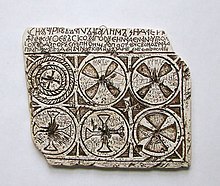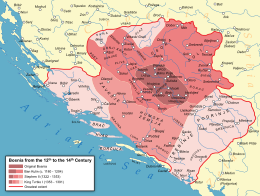Ban Kulin
| Kulin | |
|---|---|
 | |
| Ban of Bosnia | |
| Reign | 1180–1204 |
| Predecessor | Manuel I Komnenos |
| Successor | Stephen Kulinić |
| Born | Usora Bosnia |
| Died | c. November 1204 Bosnia |
| Spouse | Vojislava |
| House | Kulinić |
| Religion | Bosnian Church Roman Catholicism (briefly) |

Kulin (d. c. November 1204) was the Ban of Bosnia from 1180 to 1204, first as a vassal of the Byzantine Empire and then of the Kingdom of Hungary, although his state was de facto independent. He was one of Bosnia's most prominent and notable historic rulers and had a great effect on the development of early Bosnian history.[1] One of his most noteworthy diplomatic achievements is widely considered to have been the signing of the Charter of Ban Kulin, which encouraged trade and established peaceful relations between Dubrovnik and his realm of Bosnia.[2][3] His son, Stjepan Kulinić succeeded him as Bosnian Ban. Kulin founded the House of Kulinić.
Early life
Kulin's sister was married to Miroslav of Hum, the brother of Serbian Grand Prince Stefan Nemanja (r. 1166–1196).[4][5] Byzantine Emperor Manuel I Komnenos (1143–1180) was at that time the overlord of Bosnia.[6] In 1180, when Komnenos died, Stefan Nemanja and Kulin asserted independence of Serbia and Bosnia, respectively.[5]
Reign
His rule is often remembered as being emblematic of Bosnia's golden age, and he is a common hero of Bosnian national folk tales. Under him, the "Bosnian Age of Peace and Prosperity" would come to exist.[7] Bosnia was completely autonomous and mostly at peace during his rule.[8]
War against Byzantium
In 1183, he led his troops with the forces of the Kingdom of Hungary under King Béla and the Serbs under Stefan Nemanja, who had just launched an attack on the Byzantine Empire. The cause of the war was Hungary's non-recognition of the new emperor, Andronikos Komnenos. The united forces met little resistance in the eastern Serbian lands - the Byzantine squadrons were fighting among themselves as the local Byzantine commanders Alexios Brannes supported the new Emperor, while Andronikos Lapardes opposed him - and deserted the Imperial Army, going onto adventures on his own. Without difficulties, the Byzantines were pushed out of the Morava Valley and the allied forces breached all the way to Sofia, raiding Belgrade, Braničevo, Ravno, Niš and Sofia itself.
Bogomils
In 1199, Serbian prince Vukan Nemanjić informed the Pope, Innocent, of heresy in Bosnia. Vukan claimed that Kulin, a heretic, had welcomed the heretics whom Bernard of Split had banished, and treated them as Christians. In 1200, the Pope wrote a letter to Kulin's suzerain, the Hungarian King Emeric, warning him that “no small number of Patarenes” had gone from Split and Trogir to Ban Kulin where they were warmly welcomed, and told him to “Go and ascertain the truth of these reports and if Kulin is unwilling to recant, drive him from your lands and confiscate his property.” Kulin replied to the Pope that he did not regard the immigrants as heretics, but as Catholics, and that he was sending a few of them to Rome for examination, and also invited that a Papal representative be sent to investigate. Unconvinced, the Pope sent his legates to Bosnia to interrogate Kulin and his subjects about religion and life, and if indeed heretical, correct the situation through a prepared constitution. The Pope wrote to Bernard in 1202 that "a multitude of people in Bosnia are suspected of the damnable heresy of the Cathars." The two legates sent by the Pope went through the country of Bosnia and interrogated the clergy.
Bilino Polje abjuration
Not only did Casamaris listen to his informants’ answers, but where they were in error, he would have taught them correct doctrine, in line with Innocent's directive. John must have convinced himself that he had fulfilled Innocent's command to correct the krstjani, because the “Confessio” (Abjuration) signed at Bilino Polje by seven priors of the Krstjani church on 8 April 1203, makes no mention of errors. The same document was brought to Budapest, 30 April by Casamaris and Kulin and two abbots, where it was examined by the Hungarian King and the high clergy. Kulin's son On the surface, the “Confessio” concerned church organization and practices. The monks renounced their schism with Rome and agreed to accept Rome as the mother church. They promised to erect chapels with altars and crucifixes, where they would have priests who would say Mass and dispense Holy Communion at least seven times a year on the main feast days.
The priests would also hear confession and give penances. The monks promised to chant the hours, night and day, and to read the Old Testament as well as the New. They would follow the Church's schedule of fasts, as well as their own regimen. They also agreed to stop calling themselves krstjani—which had been their exclusive privilege—lest they cause pain to other Christians. They would wear special, uncolored robes, closed and reaching the ankles. In addition they were to have graveyards next to the church, where they would bury their brethren and any visitors who happened to die there.
Women members of the order were to have special quarters away from the men and to eat separately; nor could they be seen talking alone with a monk, lest they cause scandal. The abbots also agreed not to offer lodging to manicheans or other heretics. Finally, upon the death of the head of their order (magister), the abbots, after consultation with their fellow monks, would submit their choice to the Pope for his approval. As for the Bosnian Catholic diocese itself, John advised Innocent that they needed to break the hold of the Slavonic bishop who had ruled the Bosnian church up to then, and to appoint three or four Latin bishops, since Bosnia was a large country (“ten days’ walk”).
After the “Confessio” was approved by King Emmerich, John de Casamaris, in a letter to Innocent, refers to “the former Patarenes.”(23) Obviously, he thought that he had converted the krstjani, but he was wrong. Partly due to Rome's complacency (caused by Casamaris's feelings of success) and the Pope's failure to appoint Latin bishops, as John had suggested, the heretical movement grew stronger over the next few decades, uniting with remnants of the old native Catholic church. Together they formed a national, heretical church which survived crusades and threats of crusades until the mid-fifteenth century, when it gradually vanished in the face of the Ottoman takeover.[9][10]
Charter of Ban Kulin
The Charter of Ban Kulin was a trade agreement between Bosnia and the Republic of Ragusa that effectively regulated Ragusan trade rights in Bosnia written on 29 August 1189. It is one of the oldest written state documents in the Balkans and is among the oldest historical documents written in Bosančica. The charter is of great significance in national pride and historical heritage.[11][12]
Death
After the death of Ban Kulin in 1204, the Bosnian throne was succeeded by his son Stjepan Kulinić (often referred to in English as Stephen Kulinić).
Marriage and children
Kulin married Vojislava,[13][14] with whom he had two sons:
- Stephen Kulinić, the following Ban of Bosnia
- A son that went with the Pope's emissaries in 1203 to explain heresy accusations against Kulin
Legacy and folklore
As a founder of first de facto independent Bosnian state, Kulin was and still is highly regarded among Bosnians.[15] Even today Kulin's era is regarded as one of the most prosperous historical eras, not just for Bosnian medieval state and its feudal lords, but for the common people as well, whose lasting memory of those times is kept in Bosnian folklore, like an old folk proverb with significant meaning: "Od kulina Bana i dobrijeh dana" ("English: Since Kulin Ban and those good old days").[15]
Accordingly, in today's Bosnia and Herzegovina, many streets and town squares, as well as cultural institutions, and non-governmental organizations, bear Kulin's name, while numerous culturally significant events, manifestation, festivals and anniversaries are held in celebration of his life and deeds.[16][17]
See also
References
- ^ Malcolm, Noel (1 October 1996). Bosnia: A Short History. London: New York University Press. p. 364. ISBN 978-0814755617.[page needed]
- ^ Mahmutćehajić, Rusmir (2003). Sarajevo essays: politics, ideology, and tradition. Albany, NY: State University of New York Press. p. 252. ISBN 9780791456378.
- ^ Franz Miklosich, Monumenta Serbica, Viennae, 1858[page needed]
- ^ Fine 1994, p. 19–20.
- ^ a b Stanoje Stanojević (1931). Istorija Jugoslovena: Srba, Hrvata i Slovenaca : za srednje i stručne škole. Izd. knj. Gece Kona. p. 75.
- ^ Treadgold 1997, p. 646.
- ^ Malcolm, Noel (1 October 1996). Bosnia: A Short History. London: New York University Press. p. 364. ISBN 978-0814755617.
- ^ Bosnia and Herzegovina -- Britannica Online Encyclopedia Bosnia and Herzegovina: Ancient and Medieval Periods
- ^ Ivan, Majnarić (22 October 2008). "The papal legate Ivan de Casamaris and the 1203 act of abjuration in Bilino polje: The Papal legate who was not a legate in Bosnia". Radovi/Institute for Historical Sciences of the Croatian Academy of Sciences and Arts in Zadar : Institute for Historical Sciences of the Croatian Academy of Sciences and Arts in Zadar (in Croatian) (50). ISSN 1330-0474. Retrieved 15 April 2017.
- ^ Loos, M. (1974). Dualist Heresy in the Middle Ages (Vol. 10 ed.). ACADEMIA Publishing House of Czechoslovak Academy of Science / Springer Science & Business Media. pp. 162, 163, 164, 165. ISBN 9789024716739. Retrieved 15 April 2017.
- ^ Franz Miklosich, Monumenta Serbica, Viennae, 1858, p. 8-9.
- ^ Mahmutćehajić, Rusmir (2003). Sarajevo essays: politics, ideology, and tradition. Albany, NY: State University of New York Press. p. 252. ISBN 9780791456378.
- ^ Младен Лесковац; Александар Форишковић; Чедомир Попов (2004). Српски биографски речник. Vol. 2. Будућност. p. 293.
- ^ Nikola Čupić (1921). Godišnjica Nikole Čupića. Vol. 34–36. Štampa Državne štamparije Kraljevine Jugoslavije. p. 36.
Натпис нам, даље, изрично каже, да је Кулиновој жени било име Војислава.
- ^ a b "Dan kada je Kulin ban napisao Povelju" (in Bosnian). Al Jazeera Balkans. Al Jazeera Balkans. 29 August 2012. Retrieved 12 April 2017.
- ^ "Manifestacija "Od Kulina bana i dobrijeh dana"". rtvze.ba (in Bosnian). RTVZE. 7 April 2017. Archived from the original on 13 April 2017. Retrieved 12 April 2017.
- ^ "ZENICA Prigodan kulturno-umjetnički program povodom godišnjice Povelje Kulina bana" (in Bosnian). www.avaz.ba. Avaz. Retrieved 13 April 2017.
Further reading
- Ćirković, S. (1960). "Jedan prilog o banu Kulinu". Istorijski časopis (9–10): 71–77.
- Ćirković, Sima (2004). The Serbs. Malden: Blackwell Publishing. ISBN 9781405142915.
- Ćorović, V. (1921). "Ban Kulin". Godišnjica NČ (XXXIV): 13–41.
- Marjanović, Č. (1941). "Ban Kulin i crkva bosanska: Humska kneževina i Humska episkopija". Bratstvo. Sarajevo.
- Truhelka, Ć. (1898). "Natpis Kulina bana-[sa 2 slike u tekstu]". GZM (X). Sarajevo: 617–622.
